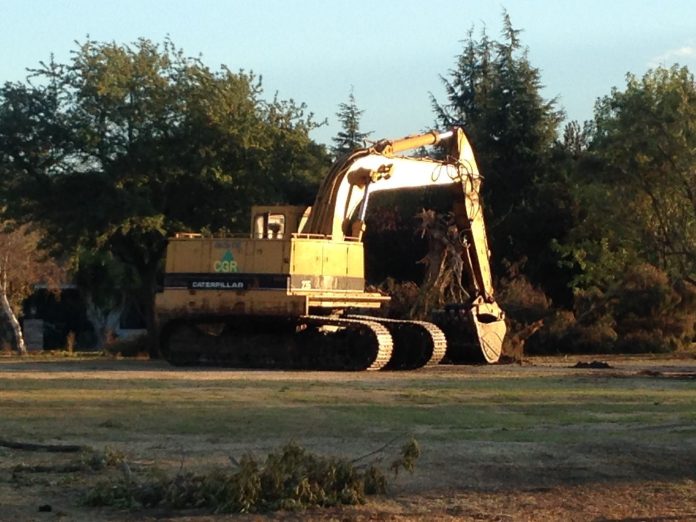When Kate Mayhorn looks out her front door, she sees piles of dead trees across the street and dirt where once there was the beginning of a green golf course fairway. From her living room window, she sees more dead grass and rows of trees marked for demolition with red X’s.
“They have marked a red X on every single tree on this fairway,” she said. “And they say they’re dead but they’re growing leaves and they look pretty fine to me.”
Mayhorn is a Hollister resident who lives just inside the gated community of Ridgemark Golf & Country Club, where course owners authorized the cutting of mature trees growing on two fairways near her house Oct. 1.
Neighbors have called the tree cutting a hit to property values and quality of life but Ridgemark President Alex Kehriotis – one of the owners of JMK Golf LLC, the company that acquired the golf course about five years ago – said the trees have become weakened and diseased since employees stopped watering them in July when the golf course closed some of its fairways and moved from a 36-hole course to an 18-hole facility.
The Ridgemark Homes Association filed a lawsuit against JMK Golf LLC in April requesting a restraining order that would put a stop to cutting down trees, while JMK asked for court permission to cut down diseased trees. The court issued a temporary restraining order, which put a stop to cutting trees not already identified in the JMK declaration, but allowed those that had already been cut to be towed away without residents interfering, according to minutes from a Tuesday court hearing.
Many of the unwatered trees being cut down are 30 to 40 feet tall and within 15 feet of houses. That makes them a liability now that winter is coming, Kehriotis said.
“One storm with rain or wind could uproot some of these trees and cause damages to some of these homes,” he said. “We’re trying to be proactive in this approach.”
An arborist walked the fairways within the last week and gave a report of which trees seemed weak or diseased, Kehriotis said.
“We’re trying to make it a safer community, and a lot of these trees represent a huge liability,” he said. “And we’re trying to do what we think is best of the community.”
The sheriff’s office responded to a call about the trees last Wednesday and wrote up an incident report but did not cite the golf course for a violation. In Hollister, there is no city ordinance protecting mature trees or requiring property owners to secure a permit before they take out their chain saws.
“We can’t make them stop,” said Eric Taylor, operations captain for the San Benito County Sheriff’s office. “There’s no state law or county ordinance regarding cutting those down unless there’s certain circumstances like a White Oak near a waterway.”
But in the neighboring city of Gilroy – just a 20-minute drive north into Santa Clara County – the rules are different and mature trees are protected. In order to cut down a tree, a property owner must secure a permit showing the tree meets certain specifications. Permits are issued, for instance, for the removal of trees that are diseased beyond reclamation or eminent hazards to previously existing buildings.
In Hollister, County Supervisor Jerry Muenzer referenced the Ridgemark tree situation at Tuesday’s regular board meeting. He suggested the county implement a tree ordinance to regulate their removal, but did not elaborate further on the matter.
The sheriff who responded to the call last week took pictures of the trees and sent them to employees at the California Department of Fish and Wildlife to make sure they weren’t a type of tree that needed a permit to be cut, because it harbored certain types of protected wildlife.
One case in which a tree would be preserved would be if it was occupied by nesting birds, but the protection would last only until the young birds were old enough to fly away, said Patrick Foy, a lieutenant with the California Department of Fish and Wildlife.
“We get that kind of thing pretty frequently,” said Foy, who noted that people can get fired up about environmental issues even when ordinances or laws aren’t being violated.
Trees can also be spared the ax under the federal Migratory Bird Treaty Act if they provide homes to migratory birds, explained Andrew Hughan, the department’s public information officer.
For residents such as Mayhorn, the concern isn’t so much about birds as it is about community aesthetics, possible flooding and property values. Mayhorn wants to know what will happen when it rains this winter and the water hits the dusty fairway where there is no longer grass or trees to soak it up.
Mayhorn rents this home, but she’s owned four others in the Ridgemark community and believes the lack of trees and grass will affect sale prices. From her house, Mayhorn can see a fairway that has been left green and is still being used by golfers. The trees are growing strong there.
“If a tree is dead, I don’t have a problem with taking it out,” she said. “But don’t put X’s on living trees that aren’t dying and aren’t dead.”










